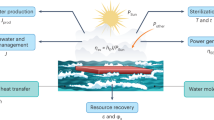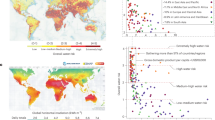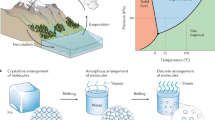Abstract
As a ubiquitous solar-thermal energy conversion process, solar-driven evaporation has attracted tremendous research attention owing to its high conversion efficiency of solar energy and transformative industrial potential. In recent years, solar-driven interfacial evaporation by localization of solar-thermal energy conversion to the air/liquid interface has been proposed as a promising alternative to conventional bulk heating-based evaporation, potentially reducing thermal losses and improving energy conversion efficiency. In this Review, we discuss the development of the key components for achieving high-performance evaporation, including solar absorbers, evaporation structures, thermal insulators and thermal concentrators, and discuss how they improve the performance of the solar-driven interfacial evaporation system. We describe the possibilities for applying this efficient solar-driven interfacial evaporation process for energy conversion applications. The exciting opportunities and challenges in both fundamental research and practical implementation of the solar-driven interfacial evaporation process are also discussed.
This is a preview of subscription content, access via your institution
Access options
Access Nature and 54 other Nature Portfolio journals
Get Nature+, our best-value online-access subscription
$29.99 / 30 days
cancel any time
Subscribe to this journal
Receive 12 digital issues and online access to articles
$119.00 per year
only $9.92 per issue
Buy this article
- Purchase on Springer Link
- Instant access to full article PDF
Prices may be subject to local taxes which are calculated during checkout







Similar content being viewed by others
References
Lewis, N. S. Research opportunities to advance solar energy utilization. Science 351, aad1920 (2016).
Chu, S., Cui, Y. & Liu, N. The path towards sustainable energy. Nat. Mater. 16, 16–22 (2017).
Crabtree, G. W. & Lewis, N. S. Solar energy conversion. Phys. Today 60, 37–42 (2007).
Weinstein, L. A. et al. Concentrating solar power. Chem. Rev. 115, 12797–12838 (2015).
Kalogirou, S. A. Solar thermal collectors and applications. Prog. Energy Combust. Sci. 30, 231–295 (2004).
Roderick, M. L. & Farquhar, G. D. The cause of decreased pan evaporation over the past 50 years. Science 298, 1410–1411 (2002).
Ohmura, A. & Wild, M. Is the hydrological cycle accelerating? Science 298, 1345–1346 (2002).
Qiblawey, H. M. & Banat, F. Solar thermal desalination technologies. Desalination 220, 633–644 (2008).
Mills, D. Advances in solar thermal electricity technology. Sol. Energy 76, 19–31 (2004).
Neumann, O. et al. Compact solar autoclave based on steam generation using broadband light-harvesting nanoparticles. Proc. Natl Acad. Sci. USA 110, 11677–11681 (2013).
Zarza, E. et al. Direct steam generation in parabolic troughs: final results and conclusions of the DISS project. Energy 29, 635–644 (2004).
Thirugnanasambandam, M., Iniyan, S. & Goic, R. A review of solar thermal technologies. Renew. Sust. Energ. Rev. 14, 312–322 (2010).
Bachhuber, C. Energy from evaporation of water. Am. J. Phys. 51, 259–264 (1983).
Cavusoglu, A. H., Chen, X., Gentine, P. & Sahin, O. Potential for natural evaporation as a reliable renewable energy resource. Nat. Commun. 8, 617 (2017). This paper identifies natural evaporation as a potential renewable energy source and quantitatively analyses the amount energy that can be harnessed from solar-driven evaporation.
Kabeel, A. E. & El-Agouz, S. A. Review of researches and developments on solar stills. Desalination 276, 1–12 (2011).
Otanicar, T. P., Phelan, P. E., Prasher, R. S., Rosengarten, G. & Taylor, R. A. Nanofluid-based direct absorption solar collector. J. Renew. Sustain. Energy 2, 033102 (2010).
Neumann, O. et al. Solar vapor generation enabled by nanoparticles. ACS Nano 7, 42–49 (2012).
Ni, G. et al. Volumetric solar heating of nanofluids for direct vapor generation. Nano Energy 17, 290–301 (2015).
Jin, H., Lin, G., Bai, L., Zeiny, A. & Wen, D. Steam generation in a nanoparticle-based solar receiver. Nano Energy 28, 397–406 (2016).
Hisatake, K., Tanaka, S. & Aizawa, Y. Evaporation rate of water in a vessel. J. Appl. Phys. 73, 7395–7401 (1993).
Prasher, R., Phelan, P. E. & Bhattacharya, P. Effect of aggregation kinetics on the thermal conductivity of nanoscale colloidal solutions (nanofluid). Nano Lett. 6, 1529–1534 (2006).
Ghadimi, A., Saidur, R. & Metselaar, H. S. C. A review of nanofluid stability properties and characterization in stationary conditions. Inter. J. Heat Mass Transf. 54, 4051–4068 (2011).
Chen, Y. et al. Stably dispersed high-temperature Fe3O4/silicone oil for direct solar thermal energy harvest. J. Mater. Chem. A 4, 17503–17511 (2016).
Yu, F. et al. Dispersion stability of thermal nanofluids. Prog. Nat. Sci. 27, 531–542 (2017).
Wang, Z. et al. Bio-inspired evaporation through plasmonic film of nanoparticles at the air–water interface. Small 10, 3234–3239 (2014). This paper is one of the first introducing the concept of localized evaporation at the air/water interface.
Ghasemi, H. et al. Solar steam generation by heat localization. Nat. Commun. 5, 4449 (2014). This paper is one of the first introducing the concept of localized evaporation at the air/water interface for steam generation.
Ni, G. et al. Steam generation under one sun enabled by a floating structure with thermal concentration. Nat. Energy 1, 12126 (2016). This work systematically analyses the energy balance for solar-driven interfacial evaporation systems, and demonstrates the thermal concentration strategy to generate steam with the solar-driven interfacial evaporator under a low solar flux level.
Zhou, L. et al. 3D self-assembly of aluminium nanoparticles for plasmon-enhanced solar desalination. Nat. Photon. 10, 393–398 (2016).
Zeng, Y. et al. Solar evaporation enhancement using floating light-absorbing magnetic particles. Energy Environ. Sci. 4, 4074–4078 (2011).
Ito, Y. et al. Multifunctional porous graphene for high-efficiency steam generation by heat localization. Adv. Mater. 27, 4302–4307 (2015).
Hu, X. Z. et al. Tailoring graphene oxide based aerogels for efficient solar steam generation under one sun. Adv. Mater. 29, 1604031 (2016).
Bae, K. et al. Flexible thin-film black gold membranes with ultrabroadband plasmonic nanofocusing for efficient solar vapour generation. Nat. Commun. 6, 10103 (2015).
Zhou, L. et al. Self-assembly of highly efficient, broadband plasmonic absorbers for solar steam generation. Sci. Adv. 2, e1501227 (2016). This paper demonstrates that spherical plasmonic nanoparticles can be assembled into efficient broadband solar absorbers with high absorptance.
Wang, X., He, Y., Liu, X., Cheng, G. & Zhu, J. Solar steam generation through bio-inspired interface heating of broadband-absorbing plasmonic membranes. Appl. Energy 195, 414–425 (2017).
Kuzmenko, A. B., Van Heumen, E., Carbone, F. & Van Der Marel, D. Universal optical conductance of graphite. Phys. Rev. Let. 100, 117401 (2008).
Xue, G. et al. Robust and low-cost flame-treated wood for high-performance solar steam generation. ACS Appl. Mater. Interfaces 9, 15052–15057 (2017).
Ma, S. et al. Recycled waste black polyurethane sponges for solar vapor generation and distillation. Appl. Energy 206, 63–69 (2017).
Wang, G. et al. Reduced graphene oxide-polyurethane nanocomposite foams as a reusable photo-receiver for efficient solar steam generation. Chem. Mater. 29, 5629–5935 (2017).
Li, Y. et al. 3D-printed, all-in-one evaporator for high-efficiency solar steam generation under 1 sun illumination. Adv. Mater. 29, 1700981 (2017).
Lou, J. et al. Bioinspired multifunctional paper-based RGO composites for solar-driven clean water generation. ACS Appl. Mater. Interfaces 8, 14628–14636 (2016).
Brongersma, M. L., Halas, N. J. & Nordlander, P. Plasmon-induced hot carrier science and technology. Nat. Nanotech. 10, 25–34 (2015).
Richardson, H. et al. Experimental and theoretical studies of light-to-heat conversion and collective heating effects in metal nanoparticle solutions. Nano Lett. 9, 1139–1146 (2009).
Hogan, N. J. et al. Nanoparticles heat through light localization. Nano Lett. 14, 4640–4645 (2014). This paper describes the achievement of interfacial evaporation using particles dispersed within a bulk solution.
Deng, Z. et al. The emergence of solar thermal utilization: solar-driven steam generation. J. Mater. Chem. A 5, 7691–7709 (2017).
Liu, Y. et al. A bioinspired, reusable, paper-based system for high-performance large-scale evaporation. Adv. Mater. 27, 2768–2774 (2015).
Zhou, L. et al. Self-assembled spectrum selective plasmonic absorbers with tunable bandwidth for solar energy conversion. Nano Energy 32, 195–200 (2017).
Guler, U., Shalaev, V. M. & Boltasseva, A. Nanoparticle plasmonics: going practical with transition metal nitrides. Mater. Today 18, 227–237 (2015).
Ishii, S., Sugavaneshwar, R. P. & Nagao, T. Titanium nitride nanoparticles as plasmonic solar heat transducers. J. Phys. Chem. C 120, 2343–2348 (2015).
Cao, F., McEnaney, K., Chen, G. & Ren, Z. A review of cermet-based spectrally selective solar absorbers. Energy Environ. Sci. 7, 1615–1627 (2014).
Zhao, D. et al. Enhancing localized evaporation through separated light absorbing centers and scattering centers. Sci. Rep. 5, 17276 (2015).
Zhang, L., Tang, B., Wu, J., Li, R. & Wang, P. Hydrophobic light-to-heat conversion membranes with self-healing ability for interfacial solar heating. Adv. Mater. 27, 4889–4894 (2015).
Liu, Y., Chen, J., Guo, D., Cao, M. & Jiang, L. Floatable, self-cleaning, and carbon-black-based superhydrophobic gauze for the solar evaporation enhancement at the air–water interface. ACS Appl. Mater. Interfaces 7, 13645–13652 (2015).
Yu, S. et al. The impact of surface chemistry on the performance of localized solar-driven evaporation system. Sci. Rep. 5, 13600 (2015). This work investigates the influence of surface chemistry on both sides of the evaporator on solar-driven evaporation behaviour and performance.
Li, X. Q. et al. Graphene oxide-based efficient and scalable solar desalination under one sun with a confined 2D water path. Proc. Natl Acad. Sci. USA 113, 13953–13958 (2016). By introducing separate hydrophilic cellulose to wick water towards the evaporating surface, the solar-driven interfacial evaporator design reported in this paper decouples the control over water supply and thermal insulation.
Osborne, N. S., Stimson, H. F. & Ginnings, D. C. Measurements of heat capacity and heat of vaporization of water in the range of 0° to 100° C. J. Res. Natl Bur. Stand. 23, 197–260 (1939).
Wang, Z. et al. Paper-based membrane on silicone floater for efficient and fast solar-driven interfacial evaporation under one sun. J. Mater. Chem. A 5, 16359–16368 (2017).
Shang, W. & Deng, T. Solar steam generation: steam by thermal concentration. Nat. Energy 1, 16133 (2016).
Dongare, P. D. et al. Nanophotonics-enabled solar membrane distillation for off-grid water purification. Proc. Natl Acad. Sci. USA 114, 6936–6941 (2017).
Liu, Z. et al. Extremely cost‐effective and efficient solar vapor generation under nonconcentrated illumination using thermally isolated black paper. Global Chall. 1, 1600006 (2017).
Ni, G. et al. A salt-rejecting floating solar still for low-cost desalination. Energy Environ. Sci. 11, 1510–1519 (2018). This work demonstrates a salt-rejecting interfacial evaporation design to enable stable and continuous outdoor solar desalination on ocean.
Khawaji, A. D., Kutubkhanah, I. K. & Wie, J. M. Advances in seawater desalination technologies. Desalination 221, 47–69 (2008).
Chang, C. et al. Efficient solar-thermal energy harvest driven by interfacial plasmonic heating-assisted evaporation. ACS Appl. Mater. Interfaces 8, 23412–23418 (2016).
Yang, P. et al. Solar-driven simultaneous steam production and electricity generation from salinity. Energy Environ. Sci. 10, 1923–1927 (2017).
Chen, X. et al. Scaling up nanoscale water-driven energy conversion into evaporation-driven engines and generators. Nat. Commun. 6, 7346 (2014). By coupling with the humidity-controlled engines, this work highlights the potential to convert evaporation energy into electrical and mechanical energy with a useful level of power.
Varghese, O. K., Paulose, M., LaTempa, T. J. & Grimes, C. A. High-rate solar photocatalytic conversion of CO2 and water vapor to hydrocarbon fuels. Nano Lett. 9, 731–737 (2009).
Liu, Y. et al. Bioinspired bifunctional bembrane for efficient clean water generation. ACS Appl. Mater. Interfaces 8, 772–779 (2016).
Chun, W., Kang, Y. H., Kwak, H. Y. & Lee, Y. S. An experimental study of the utilization of heat pipes for solar water heaters. Appl. Therm. Eng. 19, 807–817 (1999).
Sajadi, S. M., Farokhnia, N., Irajizad, P., Hasnain, M. & Ghasemi, H. Flexible artificially networked structure for ambient/high pressure solar steam generation. J. Mater. Chem. A 4, 4700–4705 (2016).
Xue, G. et al. Water-evaporation-induced electricity with nanostructured carbon materials. Nat. Nanotech. 12, 317–321 (2017).
Ding, T. et al. All-printed porous carbon film for electricity generation from evaporation-driven water flow. Adv. Funct. Mater. 27, 1700551 (2017).
Gao, F., Li, W., Wang, X., Fang, X. & Ma, M. A self-sustaining pyroelectric nanogenerator driven by water vapor. Nano Energy 22, 19–26 (2016).
Lee, M. T. et al. Hydrogen production with a solar steam-methanol reformer and colloid nanocatalyst. Int. J. Hydrog. Energy 35, 118–126 (2010).
Ravaghi-Ardebili, Z., Manenti, F., Corbetta, M., Pirola, C. & Ranzi, E. Biomass gasification using low-temperature solar-driven steam supply. Renew. Energy 74, 671–680 (2015).
Lin, Z. et al. A floating sheet for efficient photocatalytic water splitting. Adv. Energy Mater. 6, 1600510 (2016).
Wheeler, T. D. & Stroock, A. D. The transpiration of water at negative pressures in a synthetic tree. Nature 455, 208–212 (2008).
Tao, P. et al. Bioinspired engineering of thermal materials. Adv. Mater. 27, 428–463 (2015).
Zhu, M. et al. Plasmonic wood for high-efficiency solar steam generation. Adv. Energy Mater. 8, 1701028 (2018).
Liu, K. K. et al. Wood–graphene oxide composite for highly efficient solar steam generation and desalination. ACS Appl. Mater. Interfaces 9, 7675–7681 (2017).
Chen, C. et al. Highly flexible and efficient solar steam generation device. Adv. Mater. 29, 1701756 (2017).
Zhu, M. et al. Tree-inspired design for high-efficiency water extraction. Adv. Mater. 29, 1704107 (2017).
Liu, H. et al. High-performance solar steam device with layered channels: artificial tree with a reversed design. Adv. Energy Mater. 8, 1701616 (2018).
Gan, Z. et al. Photothermal contribution to enhanced photocatalytic performance of graphene-based nanocomposites. ACS Nano 8, 9304–9310 (2014).
Zhu, G., Xu, J., Zhao, W. & Huang, F. Constructing black titania with unique nanocage structure for solar desalination. ACS Appl. Mater. Interfaces 8, 31716–31721 (2016).
Ye, M. et al. Synthesis of black TiOx nanoparticles by Mg reduction of TiO2 nanocrystals and their application for solar water evaporation. Adv. Energy Mater. 7, 1601081 (2016).
Wang, J. et al. High-performance photothermal conversion of narrow-bandgap Ti2O3 nanoparticles. Adv. Mater. 29, 1603730 (2016).
Neumann, O. et al. Combining solar steam processing and solar distillation for fully off-grid production of cellulosic bioethanol. ACS Energy Lett. 2, 8–13 (2017).
Jack, C. et al. Spatial control of chemical processes on nanostructures through nano-localized water heating. Nat. Commun. 7, 10946 (2016).
Hu, H. et al. Substrateless welding of self-assembled silver nanowires at air/water interface. ACS Appl. Mater. Interfaces 8, 20483–20490 (2016).
Neumann, O. et al. Nanoparticle-mediated, light-induced phase separations. Nano Lett. 15, 7880–7885 (2015).
Zhang, Y. et al. Floating rGO-based black membranes for solar driven sterilization. Nanoscale 9, 19384–19389 (2017).
Erickson, D., Sinton, D. & Psaltis, D. Optofluidics for energy applications. Nat. Photon. 5, 583–590 (2011).
Tian, Y. & Zhao, C. Y. A review of solar collectors and thermal energy storage in solar thermal applications. Appl. Energy 104, 538–553 (2013).
Wang, Z. et al. Dynamic tuning of optical absorbers for accelerated solar-thermal energy storage. Nat. Commun. 8, 1478 (2017).
Morciano, M. et al. Efficient steam generation by inexpensive narrow gap evaporation device for solar applications. Sci. Rep. 7, 11970 (2017).
Xu, W. et al. Flexible and salt resistant Janus absorbers by electrospinning for stable and efficient solar desalination. Adv. Energy Mater. 8, 1702884 (2018).
Warsinger, D. M., Swaminathan, J., Guillen-Burrieza, E. & Arafat, H. A. Scaling and fouling in membrane distillation for desalination applications: a review. Desalination 356, 294–313 (2015).
Baker, J. S. & Dudley, L. Y. Biofouling in membrane systems—a review. Desalination 118, 81–89 (1998).
Henry, A. & Prasher, R. The prospect of high temperature solid state energy conversion to reduce the cost of concentrated solar power. Energy Environ. Sci. 7, 1819–1828 (2014).
Oelgemöller, M. Solar photochemical synthesis: from the beginnings of organic photochemistry to the solar manufacturing of commodity chemicals. Chem. Rev. 116, 9664–9682 (2016).
Acknowledgements
P.T., C.S., W.S. and T.D. received financial support from the National Key R&D Program of China (Grant No. 2017YFB0406100), National Natural Science Foundation of China (Grant No. 51521004, 51420105009, 51403127 and 21401129), the ‘Chen Guang’ project from Shanghai Municipal Education Commission and Shanghai Education Development Foundation (Grant No. 15CG06) and Shanghai Rising-Star Program (Grant No: 18QA1402200). G.C. and G.N. received funding support from the MIT S3TEC Center, an Energy Frontier Research Center funded by the Department of Energy, Office of Science, Basic Energy Sciences under Award # DE-FG02-09ER46577 (for the experimental facility) and MIT J-WAFS Solutions Program (for water treatment). J.Z. received financial support from the National Key Research and Development Program of China (No. 2017YFA0205700), the State Key Program for Basic Research of China (Grant No. 2015CB659300) and National Natural Science Foundation of China (Grant No. 11621091, 11574143).
Author information
Authors and Affiliations
Corresponding authors
Ethics declarations
Competing interests
The authors declare no competing interests.
Additional information
Publisher's note: Springer Nature remains neutral with regard to jurisdictional claims in published maps and institutional affiliations.
Rights and permissions
About this article
Cite this article
Tao, P., Ni, G., Song, C. et al. Solar-driven interfacial evaporation. Nat Energy 3, 1031–1041 (2018). https://doi.org/10.1038/s41560-018-0260-7
Received:
Accepted:
Published:
Issue Date:
DOI: https://doi.org/10.1038/s41560-018-0260-7
This article is cited by
-
Structure integration and architecture of solar-driven interfacial desalination from miniaturization designs to industrial applications
Nature Water (2024)
-
Sustainable biomimetic solar distillation with edge crystallization for passive salt collection and zero brine discharge
Nature Communications (2024)
-
Thermodiffusive desalination
Nature Communications (2024)
-
Solar-driven membrane separation for direct lithium extraction from artificial salt-lake brine
Nature Communications (2024)
-
Constructing core@shell structured photothermal nanosphere with thin carbon layer confined Co-Mn bimetals for pollutant degradation and solar interfacial water evaporation
Rare Metals (2024)



